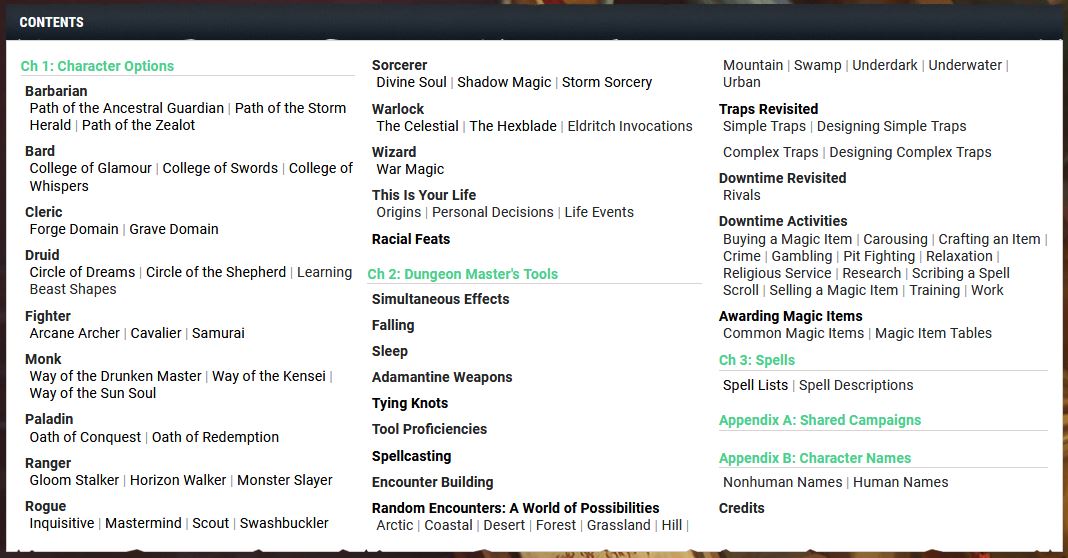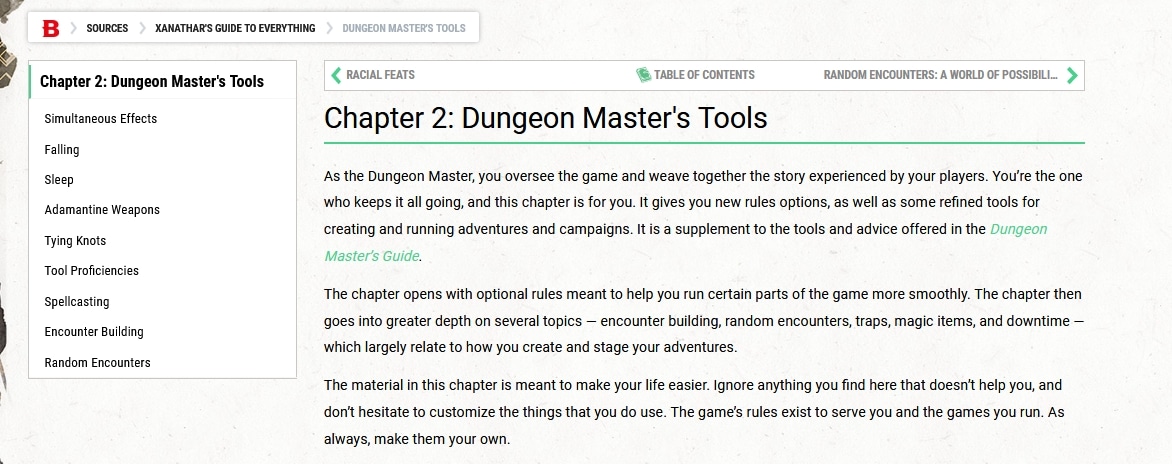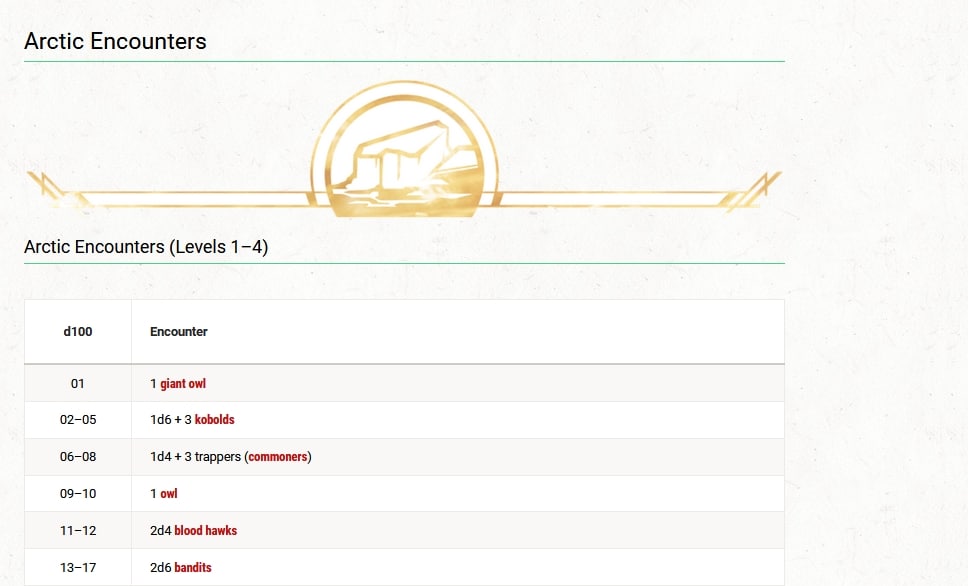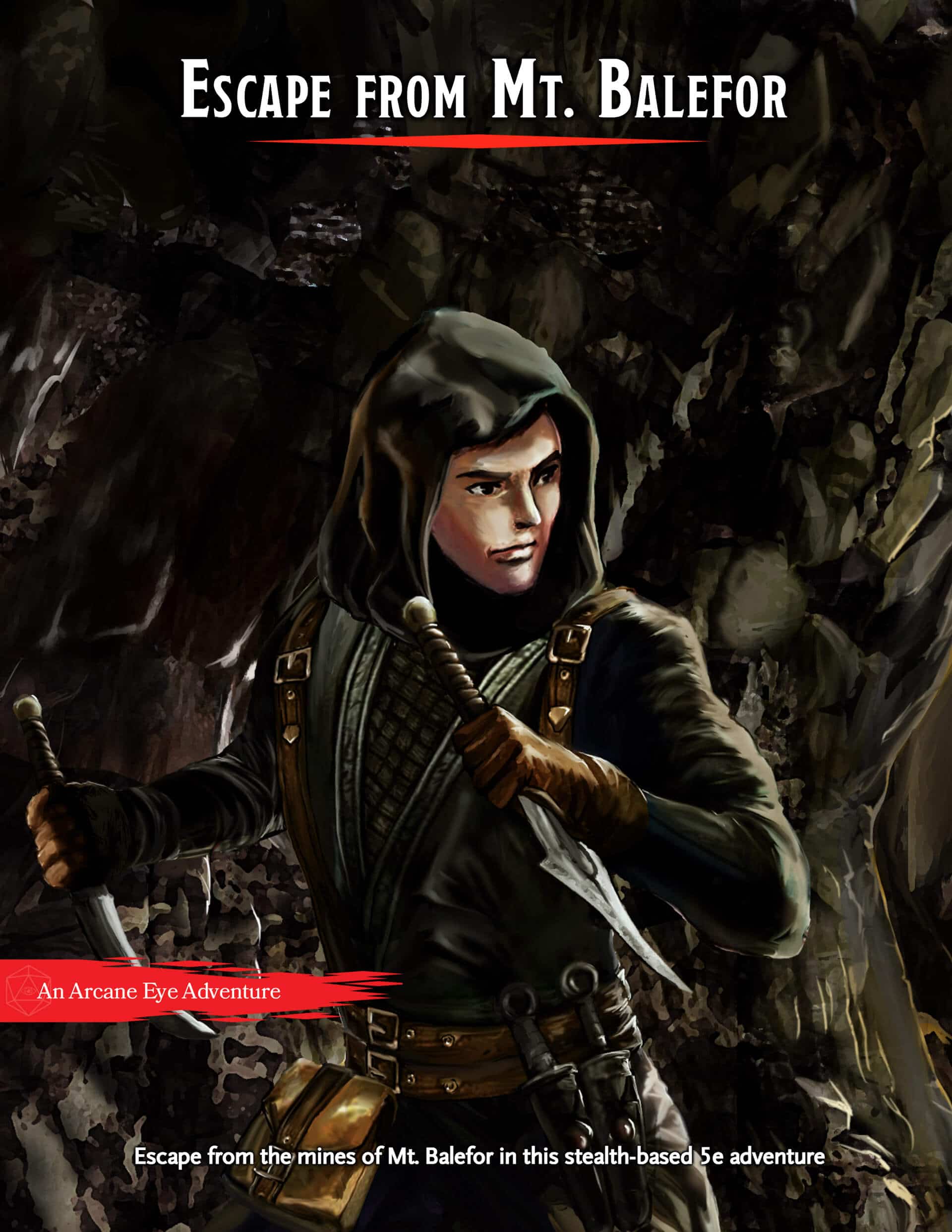Xanathar’s Guide to Everything Review
Published on July 13, 2020, Last modified on June 2nd, 2021
Xanathar’s Guide to Everything is the first major expansion for D&D 5e. It includes new subclasses, spells, racial feats, and a variety of optional rules.

Table of Contents
What is Xanathar’s Guide to Everything?
Xanathar’s Guide to Everything (XGtE) is the first major expansion for D&D 5e. It includes:
- 32 new subclasses for the character classes in the Player’s Handbook (PHB)
- 95 new spells, a collection of racial feats, and a system to give your character a randomized backstory
- A variety of tools and optional rules that allow DMs to use traps, magic items, and downtime activities more effectively
Narrating this book is Xanathar the Beholder: a curious, yet violent creature who has gathered this information from its years of research with the help of Sulgar, his goldfish.
The screenshots included in this article are from D&D Beyond because Wizards of the Coast has not officially published an electronic copy.
What is included in Xanathar’s Guide to Everything?

For Players
- Subclasses
- Character Backstory generator
- Racial Feats
- Spells
For DMs
- Additional rulings for things like falling in combat, sleeping, identifying spells, and using tools
- A great system for building and planning encounters
- Random encounter tables based on PC level and environment
- A fleshed-out guide for running traps
- Ideas for how to run downtime with your players
- Information on running shared campaigns and a character name generator
For Players
Xanathar’s Guide to Everything Subclasses

XGtE provides a TON of new subclass options, 32 in total. Each class (except the Artificer, because it wasn’t around when this book was released) gets two or three new subclass options. Most of these subclasses are covered in our Class Guides, but for a bird’s eye view, they are as follows:
Barbarian
- Path of the Ancestral Guardian – Protect yourself and your allies by calling upon the ghosts of your ancestors.
- Path of the Storm Herald – Gain access to damage buffs and resistances based on the element you choose for your Rage.
- Path of the Zealot – Become a warrior of the Gods and strike with their divine fury.
Bard
- College of Glamour – You went to College in the Feywild and you have the eloquent speech and beauty of one of the fey.
- College of Swords – Gain access to medium armor and wade into battle with fighting styles and flourishes.
- College of Whispers – Bards that trade in secrets and whispers.
Cleric
- Forge Domain – Craft and use heavy armor and powerful magic weapons to defeat the forces of darkness.
- Grave Domain – Become a guardian of life and death. Put restless spirits to rest and stave off death for those whose time has not yet come.
Druid
- Circle of Dreams – Become imbued with the healing power of the Feywild.
- Circle of the Shepherd – Commune with the spirits of nature to protect the party and Mother Earth.
Fighter
- Arcane Archer – Use magic-infused arrows to defeat those who will oppose you in battle.
- Cavalier – Become an expert in mounted combat.
- Samurai – You draw on your implacable fighting spirit to overcome your enemies.
Monk
- Way of the Drunken Master – Move in the jerky, unpredictable movements of a drunkard to avoid damage and surprise your enemies in combat.
- Way of the Kensei – Imbue your weapons with the energy of your Ki.
- Way of the Sun Soul – Channel your life energy into searing bolts of radiant light.
Paladin
- Oath of Conquest – Swear an Oath to crush your enemies in battle.
- Oath of Redemption – Swear an Oath to set those who walk in the darkness to a righteous path.
Ranger
- Gloom Stalker – Gloom Stalkers are at home in the darkest places: deep under the earth, in gloomy alleyways, in primeval forests, and wherever else the light dims.
- Horizon Walker – Rangers that protect the material plane from extraplanar threats.
- Monster Slayer – Trained in supernatural techniques to overcome even the most deadly monsters, Monster Slayers are experts at unearthing and defeating mighty, mystical foes.
Rogue
- Inquisitive – Your sharp eye for detail provides advantages in combat and social situations.
- Mastermind – Your focus is on people and on the influence and secrets they have. Words are your weapons as often as knives or poison, and secrets and favors are some of your favorite treasures.
- Scout – You are skilled in stealth and surviving far from the streets of a city. Rogues who embrace this archetype are at home in the wilderness and among Barbarians and Rangers.
- Swashbuckler – You focus your training on the art of the blade, relying on speed, elegance, and charm in equal parts.
Sorcerer
- Divine Soul – Your innate magic stems from a distant, powerful blood connection with the divine.
- Shadow Magic – You are a creature of shadow, for your innate magic comes from the Shadowfell itself. You might trace your lineage to an entity from that place, or perhaps you were exposed to its fell energy and transformed by it.
- Storm Sorcery – The magic of storm permeates your being. This power may have come from a powerful elemental, or that your fate is tied to the essence of a powerful storm.
Warlock
- The Celestial – Your pact with that divine being of the Upper Planes allows you to experience the holy light that illuminates the multiverse.
- The Hexblade – You have made your pact with a mysterious entity from the Shadowfell — a force that manifests in sentient magic weapons carved from the stuff of shadow.
Wizard
- War Magic – The tradition of War Magic blends principles of evocation and abjuration, rather than specializing in either of those schools.
In my opinion, this is really the meat and potatoes of Xanathar’s Guide to Everything. The subclasses section takes up 52 pages of the 192 page book, significantly more than any other one section.
This is also where you will get the most value out of the book. Buying this on D&D Beyond, or in paper, will give you and your players access to nearly double the amount of subclass options than the PHB alone. This is significantly more than any other sourcebook available at the time of writing.
Now, you may be asking, “Well, yeah there are a lot of subclasses. But are they good?” The answer to this, in my honest opinion, is yes. Xanathar’s Guide to Everything has some of the most fun to play subclasses that can completely shake up the way a character is played.
Favorite Subclasses
Hexblade Warlock
Man, this really changes the tune on Warlocks. I used to shy away from Warlocks when I first started off and only had the PHB, because they usually boiled down to casting Eldritch Blast until whatever was in front of you was dead. Hexblade completely validates Pact of the Blade Warlocks, a benefit very similar to DEX based characters, because your CHA is now used for attack rolls, damage, spellcasting, and social situations.
I find that the Hexblade plays very similarly to Eldritch Knights (another favorite class), in the sense that it provides a ton of options in combat. Am I going to use my first bonus action to Hex or Hexblade’s Curse? Should I be saving my spell slots for a shield or an AoE attack?
If you are looking for a class that has a good mix of utility, melee damage, ranged damage, and spellcasting, the Hexblade Warlock is for you.
You can read more about the Hexblade Warlock in our Warlock Guide.
Kensei Monk
This class gets top marks across the board. Clean. Efficient. Practical. All while still being a ton of fun to play.
The Kensei weapons feature allows you to extend the Monk Weapon options. These Kensei weapons can also help boost your ranged offense or defense without needing to expend any ki points. This is something that the PHB Monks greatly needed.
You can read more about the Way of the Kensei Monk in our Monk Guide.
Gloomstalker Ranger
What can I say, the Gloomstalker Ranger is just….so….cool. Everything from the flavor of the subclass, to the features, to the spells, is just so on point that it almost makes up for the unfortunate Favored Enemy and Natural Explorer flubs.
You can read more about the Gloomstalker Ranger in our Ranger Guide.
Least Favorite Subclasses
War Magic Wizard
The War Magic Wizard was certainly one of the biggest letdowns from XGtE. The PHB Wizard subclasses left a fair bit to the imagination, mainly because of how uninspired they were.
I think the tricky thing that Wizard’s of the Coast is trying to balance here is the sheer fact that Wizards have insane amounts of utility because of the number of spells they can get access to.
This leaves the War Magic Wizard with the shell of a really good subclass, but it just ends up feeling hollow. The ability to maintain concentration easily is a nice touch but is something that has already been solved by a number of feats available in the PHB.
The biggest disappointment is the Power Surge which, despite its cool name, is extremely lackluster.
College of Whispers Bard
The College of Whispers Bard is an interesting one for me. I usually really like Bards, but I have found that this particular College is hard to balance.
In combat-centric, linear campaigns, the College of Whispers Bard is going to have a really tough time finding their time to shine.
In political, RP heavy campaigns, the College of Whispers Bard is straight-up game-breaking. If used to its full capabilities, it’s class features can completely negate the air of mystery and distrust that is so important to these types of games.
Arcane Archer Fighter
The Arcane Archer falls into a dangerous pit that the Eldritch Knight just managed to avoid. All but two of the Arcane Shot options rely on the fact that you aren’t going to dump your INT stat because they require the creatures to fail saves to be fully effective.
DEX based Fighters don’t have as much of an issue with pumping INT and STR based fighters do. This is mainly because they can rely on DEX for their AC (using medium armor), and attack rolls while neglecting CON because they aren’t going to be in the front lines quite as much.
All in all, the Arcane Archer subclass feels like it would have fit better on a Ranger, who naturally has a reason to pump DEX and their spellcasting modifier. Instead, they shoehorned it onto a Fighter and it just doesn’t feel right.
Xanathar’s Guide to Everything Racial Feats
XGtE introduces a new mechanic: Racial Feats. These are similar to the feats presented in the PHB, with the exception that they can only apply to a certain race.
These feats range from hardening the scales of Dragonborn to provide an unarmored AC, to allowing Halflings to let their Luck transfer to other creatures.
While these feats are flavorful and interesting, none of them are quite as strong as the ones in the PHB. Seeing as D&D 5e’s Races usually dictate the class you will play, a lot of these feats end up being redundant or not useful if you try to expand the race’s horizons.
I’m not saying this is a good or a bad thing, I am just saying that players will be less likely to exchange an ASI for one of them.
Xanathar’s Guide to Everything Spells

Next to the subclasses, this is one of the best reasons to buy this sourcebook.
XGtE contains 95 new spells for players to choose from. As with the PHB, each class has access to some of these spells and they range from cantrips to 9th Level.
Covering each spell would be an extremely large task, and has already been done very well by Redditor u/jpvasku here.
If you are a Wizard who is itching to thicken out their spellbook, XGtE is the best place to start.
For DMs
XGtE contains a wealth of rules, encounters, and ideas for campaigns. If, after reading the Dungeon Master’s Guide, you are still looking to expand your DM education, XGtE is the best logical next step.
Rules

XGtE contains clarification on rules, such as how to resolve falling in combat, or how sleeping works in the 5e system. While some people might be bored by the aspect of reading more rules and working them into their campaigns, I absolutely love it.
I think addressing stuff like how sleep can affect your players really helps to extend the choices that they have to make when playing and can make the games feel more real.
My favorite rule extensions from XGtE are Tool Proficiencies and Spellcasting.
Tool Proficiencies
XGtE covers every tool available in the DMG and explains how proficiencies in said tool actually work.
There was (and still is) a fair amount of unclarity among players and DMs as to what tool proficiencies can actually do. This causes tools to end up being overlooked when really, they are one of the best ways to add flavor to your character.
For example, XGtE explains that proficiency with the Alchemist’s Supplies enables characters to brew cool concoctions, like acid or alchemist’s fire. The proficiency with this tool also allows you to better identify potions and use investigation to ascertain which chemicals may be present in an area.
For me, this is a HUGE upgrade to what we were given in the DMG and allows players to really customize their characters using tools.
Spellcasting
XGtE dives a bit deeper into how spells are perceived based on the components needed to cast them.
My favorite rule extension revolves around identifying spells because, as noted in the PHB, players normally don’t know that a spell has been cast unless the spell produces a noticeable effect.
I also think this is a great tool for Wizard’s spellbooks and can allow them to expand the list of spells they know without having to find scrolls (but this is a homebrew mechanic).
Encounters

One of the more difficult things for even the most seasoned DMs is encounter building. This is due to a number of factors, most of which are covered in our Guide to Building Encounters.
One thing XGtE does really well is expanding on the Challenge Rating (CR) mechanic. They explain that CR isn’t a set mechanic; it is fluid based on the number and level of PCs.
This is mainly trying to address the fact that a party of level 2 adventurers will find a CR 2 monster to be deadly, whereas a party of 4 level 12 adventurers will likely find a CR 12 monster to be an easy match.
This chapter breaks down how to deal with individual monsters as well as groups of monsters based on the party’s level and the number of players. It provides a number of helpful, easy to read charts as well as a step by step approach on how to effectively design your encounters.
Ideas
On top of new rule options, XGtE also explores ideas for encounters, traps, and downtime. This section, in my opinion, has the most “re-readability”. Even after finishing this book, I find myself flipping through the back of the book to find inspiration for encounters in specific terrain or downtime activities for my players.
Random Encounter Tables

Some would say the Random Encounter tables are somewhat negated by the fact that Kobold Fight Club exists, but I love the fact that these tables are so varied (usually containing more than 20 possible outcomes) and they aren’t necessarily limited to just combat encounters.
For example, on the Arctic Encounters (Levels 5–10) table, a 61-65 will have the party encounter 1d4 hours of extreme cold. This is a deadly encounter in its own right and may be something that the PCs have to think outside of the box to overcome.
Traps
You may have noticed from reading our other articles, but we love coming up with systems to help run certain situations in D&D 5e. This could be something as simple as a stealth mission or something as complex as creating your very own D&D city.
I absolutely love this chapter on traps. As noted before, XGtE is meant to be an extension of the DMG and I think that the Traps Revisited section does a great job building on the foundation that the DMG provided.
Again, the distinction between simple traps and complex traps is made. XGtE introduces new layers that can help these traps become full encounters on their own.
XGtE delves into the philosophies of designing traps, such as their purpose, lethality, triggers, effects, how to disarm them, and how to place them. I love this approach and I feel like it is something greatly missed in the DMG.
As the old adage goes, give a goblin a trapped bear and he will eat for a day. Teach a goblin how to effectively create and execute a bear trap and he will eat for a lifetime.
Magic Items

This last section creates a new system that identifies magic items as minor or major items. This distinction is laid out in a number of easy to read tables that list the items by their rarity.
This system is then used to denote how many of each type of magic item PCs should be getting at their level. This, in my opinion, is a great system and can help ensure you don’t accidentally break the balance of your campaign by providing too many magical items, or by giving players access to powerful magical items too soon.
Is Xanathar’s Guide to Everything worth it?
Short answer: yes.
Long answer: XGtE is, in my opinion, the next step for players and DMs to take once they want more from D&D 5e.
After getting used to the basic rules and getting comfortable with the structure of a campaign, XGtE is an amazing way to breathe life and additional choices into the game. XGtE provides a great stepping stone for intermediate DMs and Players to dabble with content outside of the core rule books while not introducing anything totally broken (looking at you, Aarakocra from Elemental Evil Player’s Companion).
It also provides a wealth of new rules and creative ideas for DMs to supplement their world-building for the 5th edition of Dungeons & Dragons.
If you would like to support Arcane Eye, you can buy Xanathar’s Guide to Everything through our Amazon Affiliate link here:
